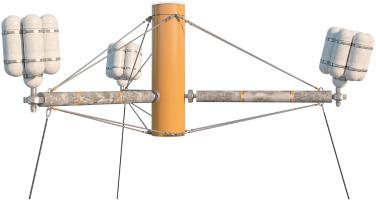Ocean Engineering ( IF 5 ) Pub Date : 2021-04-05 , DOI: 10.1016/j.oceaneng.2021.108792 Rick Damiani , Max Franchi

|
The SpiderFLOAT (SF) is an offshore wind turbine substructure that promises to drastically reduce project capital expenditure via its modularized slender structure, efficient load path, and effective use of materials. The structural design of the SF must both guarantee component reliability as well as floater stability. This article discusses the theory and the analytically developed method to determine the internal loads and the required dimensions of the SF's main components during preliminary design. The classical elastic beam theory is extended to a higher order to account for buckling risk and shortening due to bending, and applied to the SF's typical leg member. Two key load cases are considered in this preliminary sizing, analyzed against both service and ultimate limit states (SLS and ULS). The first loading scenario occurs on a dry-dock during SF's assembly and is associated with the pretensioning of the cables, which realizes both the overall structure stiffness as well as the concrete leg and stem prestress. The second load case is an operational condition at sea and near turbine rated-power. After assessing the loads, the leg dimensions and the reinforcement geometry are determined by satisfying both SLS and ULS requirements based on design standards. The newly developed structural model is implemented in the software tool SOFT4S which was verified against ANSYS. The excellent agreement between the two codes proved that the computationally light SOFT4S can be reliably used in the optimization of the SF components in the context of control co-design, where both controls and structures are simultaneously designed to reduce overall costs.
中文翻译:

SpiderFLOAT海上风能平台结构优化的创新二阶设计方法
SpiderFLOAT(SF)是一种海上风机子结构,通过其模块化的细长结构,有效的载荷路径和有效的材料使用,有望大幅度减少项目资本支出。SF的结构设计必须既要保证组件的可靠性,又要保证浮子的稳定性。本文讨论了在初步设计过程中确定SF主要部件的内部载荷和所需尺寸的理论和分析方法。经典的弹性梁理论被扩展到更高的级别,以解决弯曲导致的屈曲风险和缩短,并应用于SF的典型支腿构件。在此初步规模确定中考虑了两个关键的负载情况,并针对服务状态和最终极限状态(SLS和ULS)进行了分析。SF组装过程中的第一个加载情况发生在干船坞上,并且与电缆的预紧有关,这既实现了整体结构刚度又实现了混凝土支腿和主干的预应力。第二种负载情况是海上和接近涡轮额定功率的运行条件。在评估载荷之后,根据设计标准,通过同时满足SLS和ULS要求来确定支腿尺寸和钢筋几何形状。新开发的结构模型在已通过ANSYS验证的软件工具SOFT4S中实现。两种代码之间的出色一致性证明,在控制协同设计的背景下,轻巧的SOFT4S可以可靠地用于SF组件的优化,


























 京公网安备 11010802027423号
京公网安备 11010802027423号